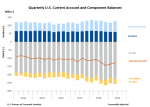Economic indicators
We are the world’s most trusted, impartial source of comprehensive data about the U.S. economy. Every five years the Census Bureau conducts an Economic Census and Census of Governments, in addition to more than 100 other surveys conducted monthly, quarterly, or annually.
From these censuses and surveys 13 economic indicators are produced, serving as the foundation for gross domestic product (GDP). Produced by the Bureau of Economic Analysis, GDP data is ranked as one of the three most influential economic measures that affect U.S. financial markets.








